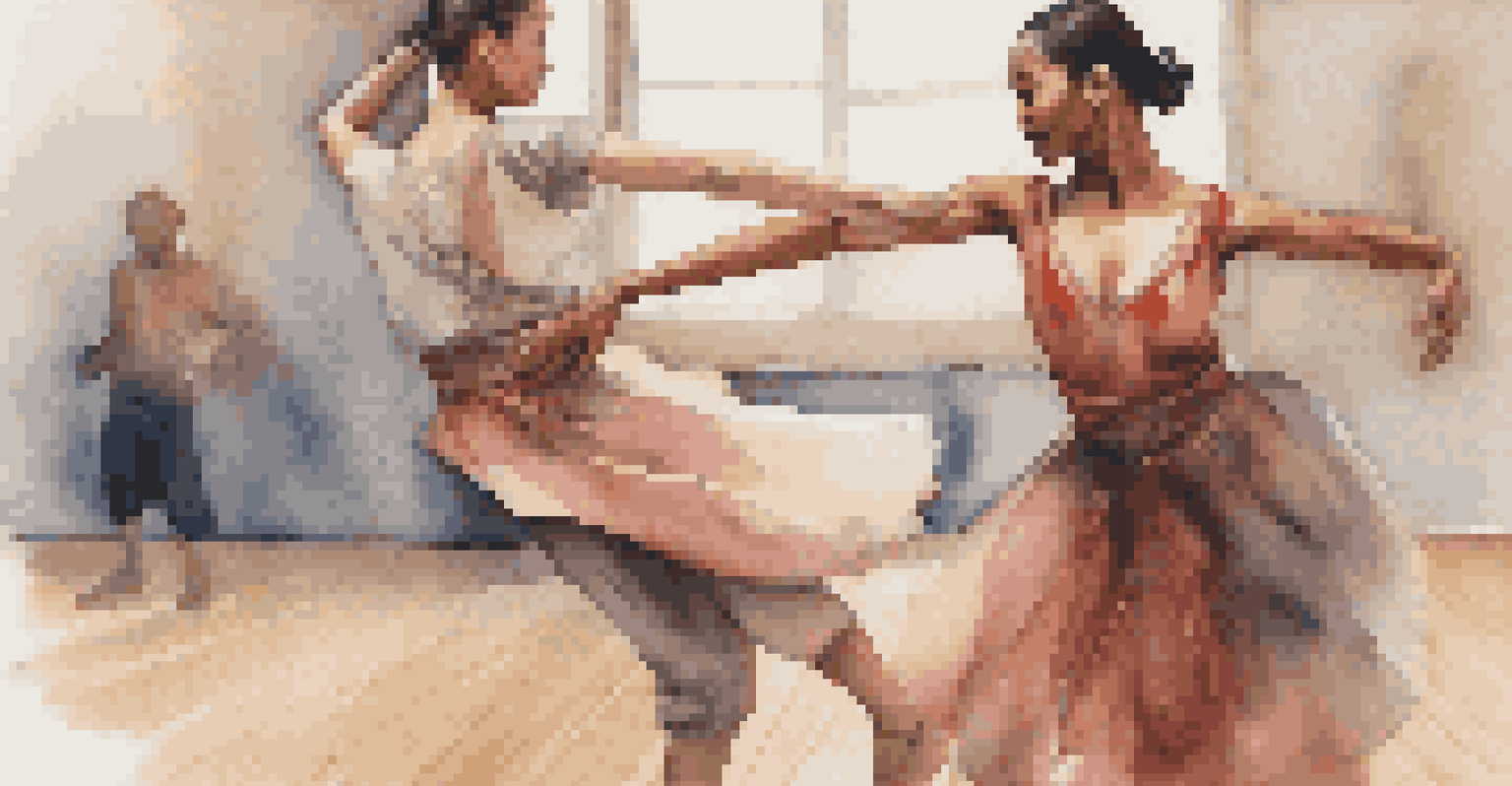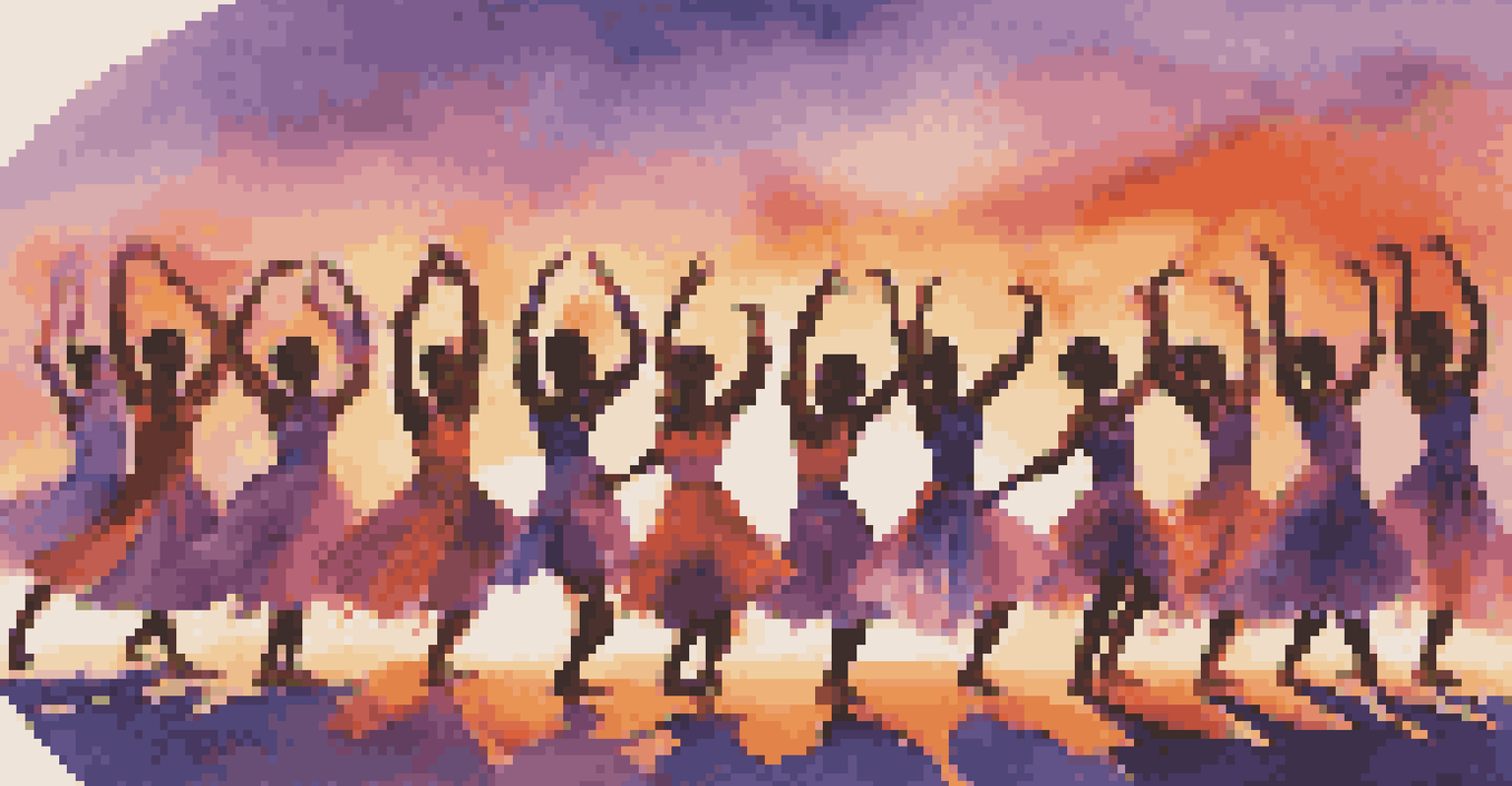Collaborative Dance Projects: Uniting Diverse Performers

The Essence of Collaborative Dance Projects
Collaborative dance projects are more than just performances; they are vibrant expressions of creativity that bring together unique talents. These projects often blend various dance styles, cultures, and backgrounds, creating a rich tapestry of movement. Imagine a stage where ballet meets hip-hop, or traditional folk dances intertwine with contemporary styles—the possibilities are endless! Collaboration fosters an environment where artists can share their stories and perspectives, resulting in a dynamic art form that resonates with audiences.
Diversity is not a reason for division; it is a reason for unity.
In these projects, the emphasis is on teamwork and mutual respect, as each dancer contributes their own voice to the collective. This process not only enhances the final performance but also enriches the individual dancers, allowing them to grow and evolve. For many, it's a transformative experience that challenges their skills and ignites their passion for dance.
Moreover, collaborative projects often encourage inclusivity and representation, providing a platform for underrepresented voices in the dance community. By uniting diverse performers, these projects challenge stereotypes and promote understanding, making dance a powerful tool for social change.
Building Bridges: The Role of Diversity in Dance
Diversity is a cornerstone of collaborative dance projects, and it offers countless benefits to both performers and audiences. When dancers from different backgrounds come together, they bring with them a wealth of experiences, techniques, and cultural narratives. This melting pot of ideas can lead to innovative choreography that pushes boundaries and captivates viewers.

For example, a project involving dancers from various cultural heritages can highlight the beauty of each tradition while also showcasing how they can coexist harmoniously. This not only enriches the artistic process but also fosters connections between diverse communities, breaking down barriers and promoting dialogue.
Collaboration Enhances Creativity
Collaborative dance projects merge diverse talents and styles, resulting in innovative performances that resonate with audiences.
Additionally, audiences are often drawn to the authenticity and relatability that comes from seeing their own stories reflected on stage. When performers represent a broad spectrum of identities, it allows for a deeper emotional connection, as viewers can see themselves in the art being presented.
Creative Collaboration: Choreography in Action
At the heart of any successful collaborative dance project is the choreography, which serves as the common language among performers. The process of creating choreography collaboratively can be exhilarating and challenging, as dancers must compromise and blend their styles. This is where the magic happens—when different movement vocabularies merge to create something entirely new and unexpected.
Art is the most beautiful of all lies; it is the dream of truth.
Choreographers often act as facilitators, guiding the process while encouraging input from all dancers. This not only empowers each performer but also fosters a sense of ownership over the final piece. Imagine a brainstorming session where everyone contributes ideas, leading to a unique choreography that reflects the collective creativity of the group.
Moreover, the collaborative nature of choreography promotes experimentation and risk-taking. Dancers are encouraged to step outside their comfort zones, which can lead to innovative movement patterns and a refreshing take on traditional techniques. This spirit of exploration is what keeps dance evolving and exciting.
The Impact of Technology on Collaborative Dance
In today's digital age, technology plays a crucial role in enhancing collaborative dance projects. From virtual rehearsals to online platforms for sharing ideas, technology has made it easier for dancers from different locations to come together. This has opened doors for international collaborations, allowing performers to work together despite geographical barriers.
Additionally, advancements in video editing and projection techniques have transformed the way dance is presented. Dancers can now incorporate multimedia elements into their performances, creating a more immersive experience for the audience. Imagine a performance that blends live dance with projected visuals, telling a story that transcends the stage.
Diversity Fuels Artistic Expression
The inclusion of various cultural narratives in dance fosters deeper emotional connections and promotes understanding among communities.
Furthermore, social media allows for real-time feedback and connection, enabling dancers to share their journeys and experiences with a wider audience. This not only helps to build a community around collaborative dance but also encourages more people to get involved and appreciate this unique art form.
Challenges in Collaborative Dance Projects
While collaborative dance projects are incredibly rewarding, they are not without their challenges. One significant hurdle is the potential for miscommunication among dancers with different backgrounds and expectations. Establishing clear communication channels and mutual understanding from the outset is essential to ensure that everyone is on the same page.
Additionally, navigating the creative differences and preferences of diverse performers can lead to conflicts. It's important for the team to focus on collaboration rather than competition, fostering a supportive environment where everyone's voice is valued. Regular check-ins and open dialogues can help to address any issues before they escalate.
Despite these challenges, the rewards of overcoming them are immense. The process of working through differences can strengthen bonds among performers and lead to a more cohesive final product. Ultimately, these challenges can serve as valuable learning experiences that enhance both personal and artistic growth.
Spotlight on Successful Collaborative Dance Projects
There have been numerous successful collaborative dance projects that highlight the beauty of unity in diversity. One notable example is the 'Dance Across Borders' initiative, which brought together dancers from different countries to create a performance that celebrated their unique cultural heritage while also showcasing shared themes of human experience. This project not only captivated audiences but also fostered lasting friendships among the performers.
Another inspiring example is the 'Dancers Without Borders' program, which focuses on providing opportunities for underprivileged dancers to collaborate with professionals in the industry. This initiative not only elevates the performers but also enriches the collaborative process, as each dancer brings a unique perspective and talent to the table.
Technology Expands Dance Opportunities
Advancements in technology facilitate virtual collaborations and multimedia integration, enriching the collaborative dance experience.
These projects serve as a testament to the power of collaborative dance, demonstrating that when artists unite, they can create something truly extraordinary. They inspire others in the community to explore collaboration and highlight the importance of diversity in the arts.
The Future of Collaborative Dance Projects
As we look to the future, the potential for collaborative dance projects is limitless. With the continued growth of global connectivity, we can expect to see even more cross-cultural collaborations that celebrate diversity and creativity. The blending of various dance styles and traditions will likely lead to new forms of artistic expression that challenge conventional norms.
Moreover, as awareness around social issues grows, collaborative dance projects can serve as powerful platforms for advocacy and change. Dancers can use their art to address pressing issues such as inequality, climate change, and cultural preservation, sparking important conversations within their communities.

Ultimately, the future of collaborative dance is bright, inviting artists and audiences alike to embrace the beauty of unity in diversity. As more performers come together to share their stories, the dance world will continue to evolve, reflecting the richness of our shared human experience.